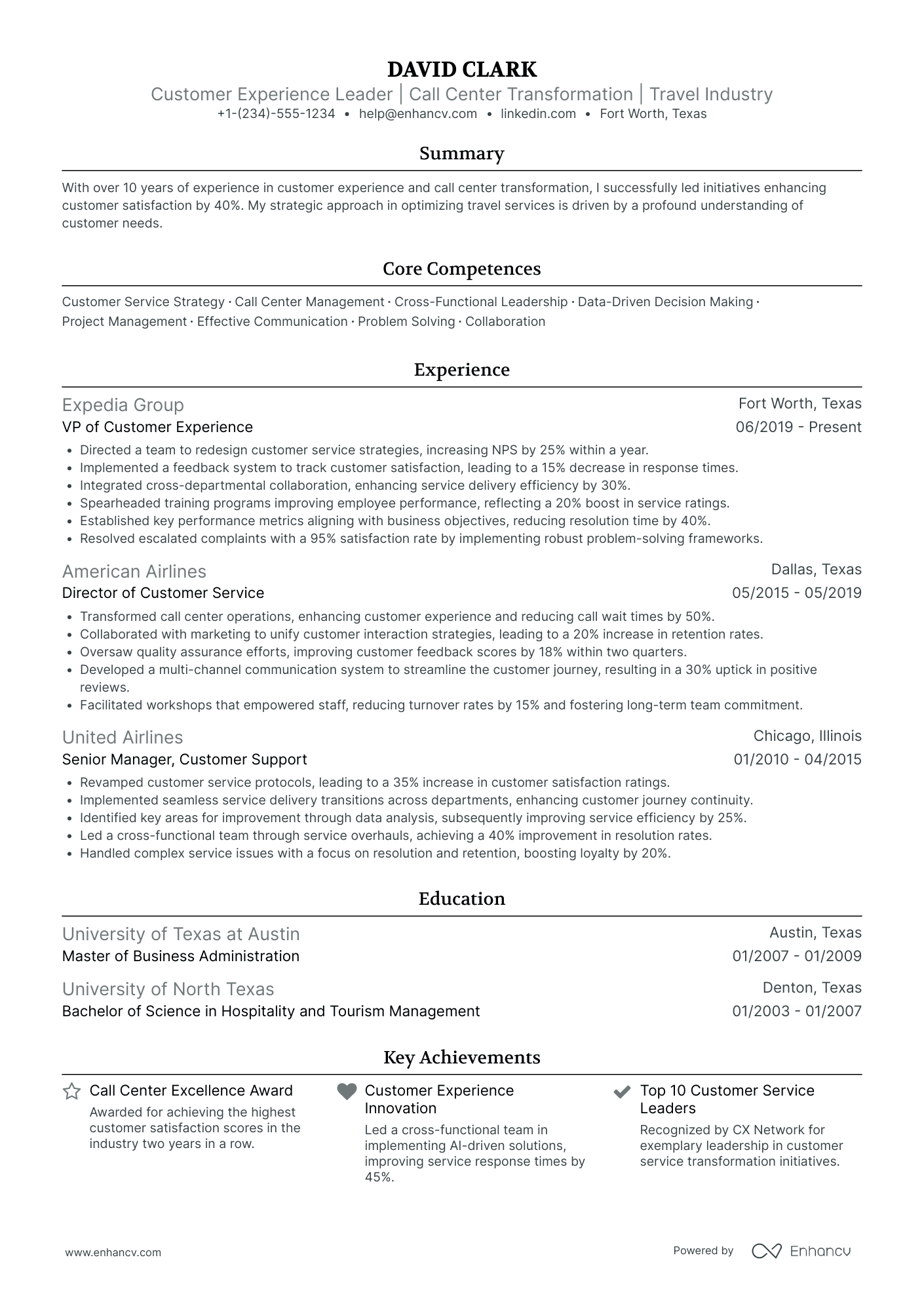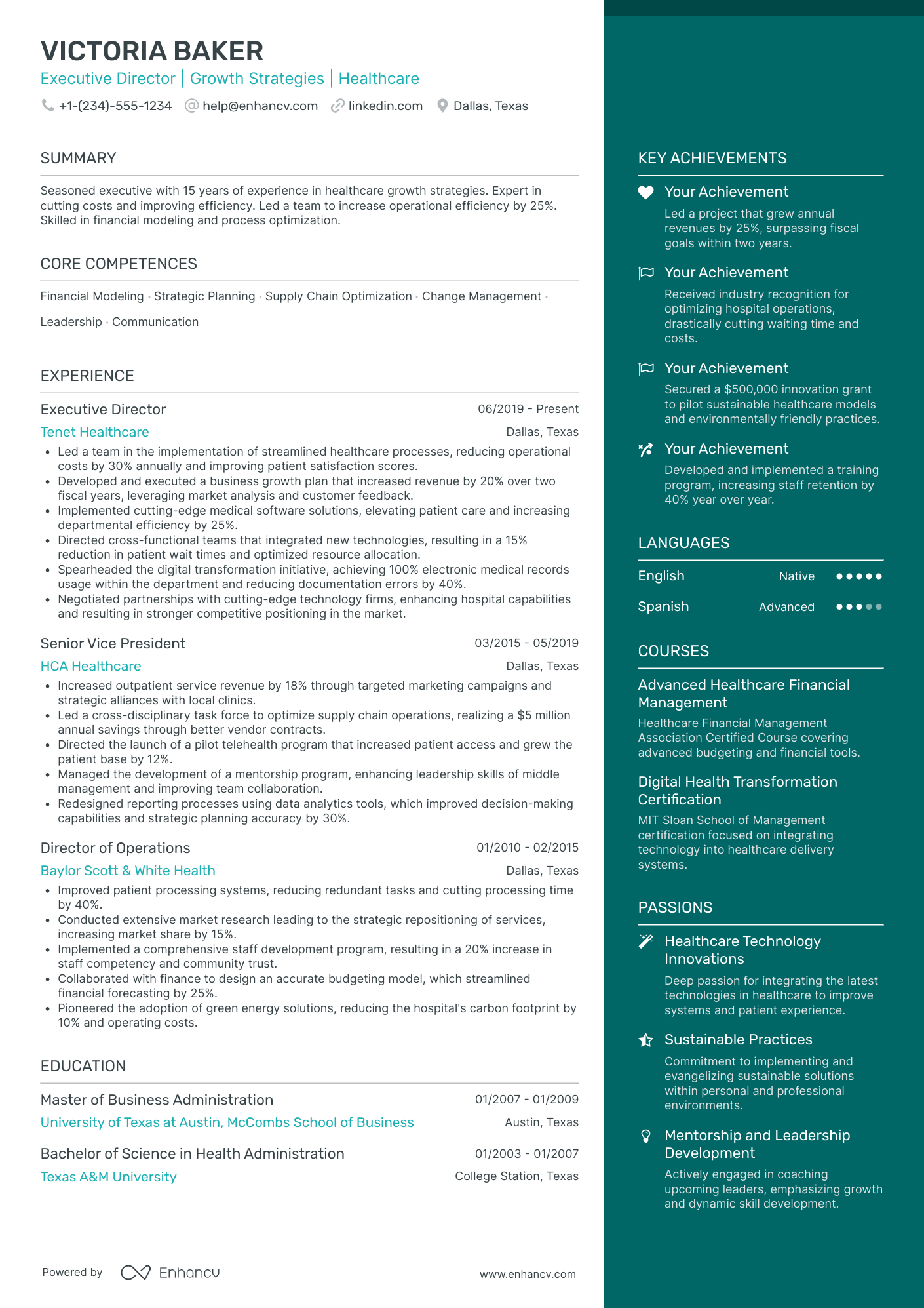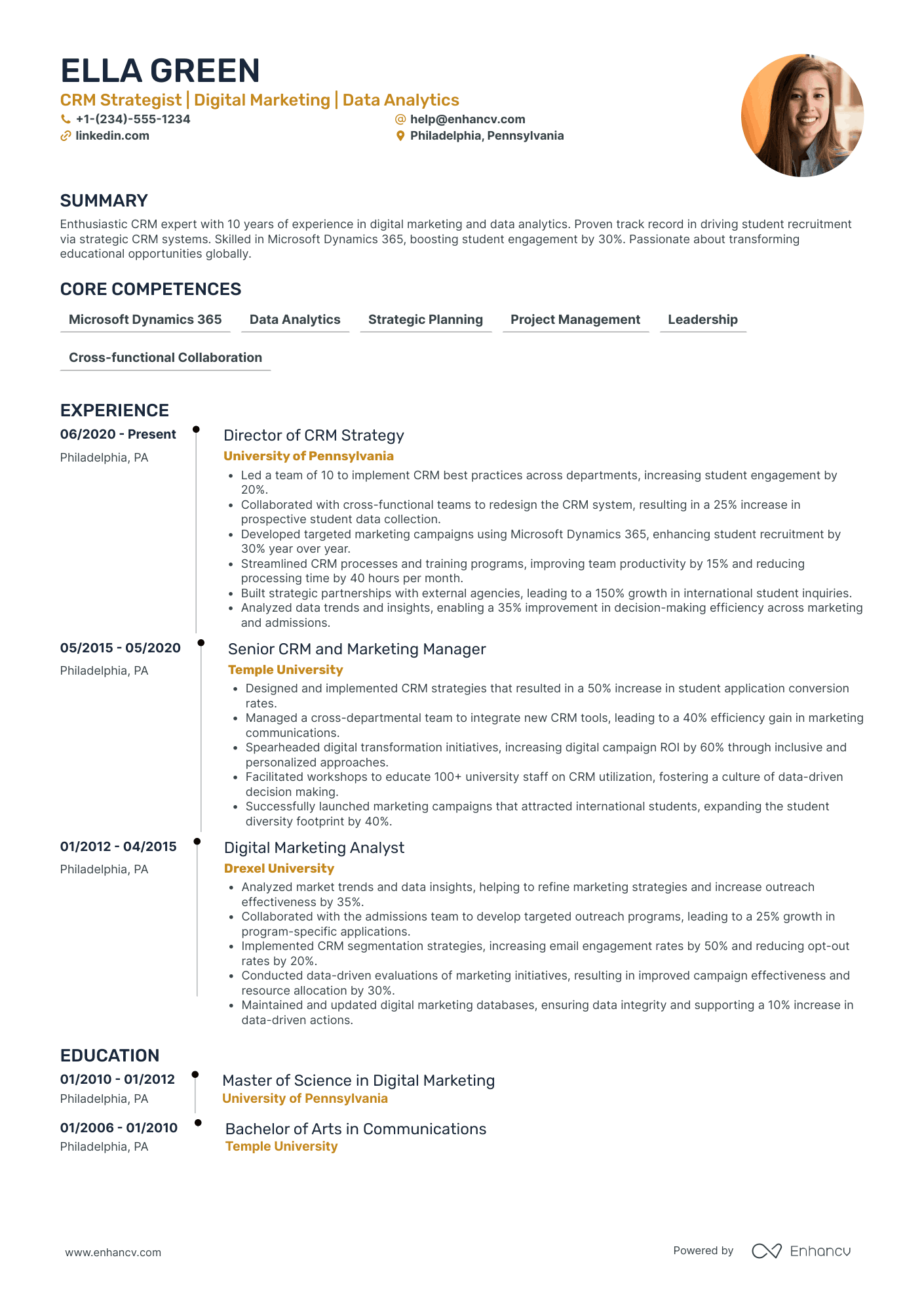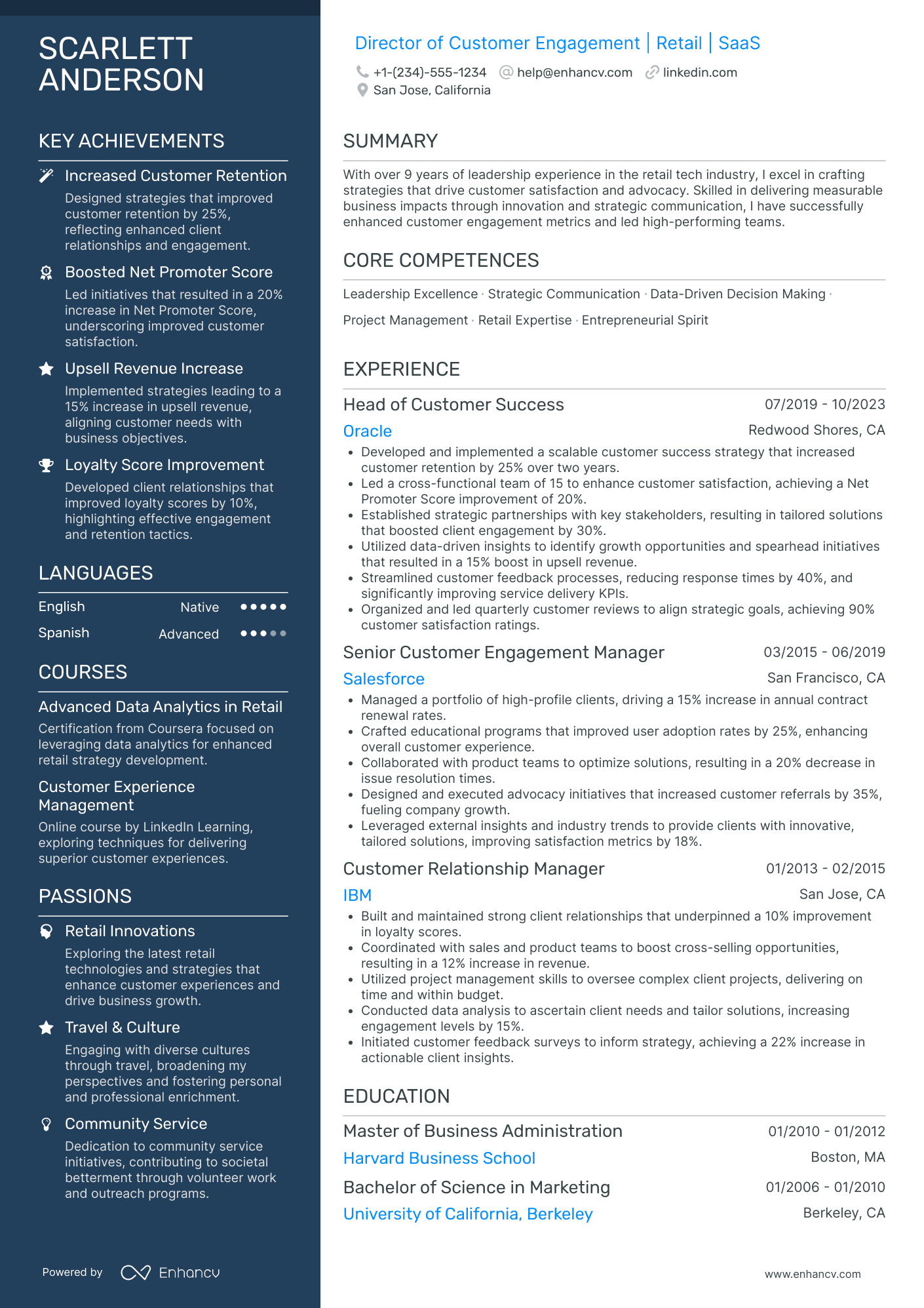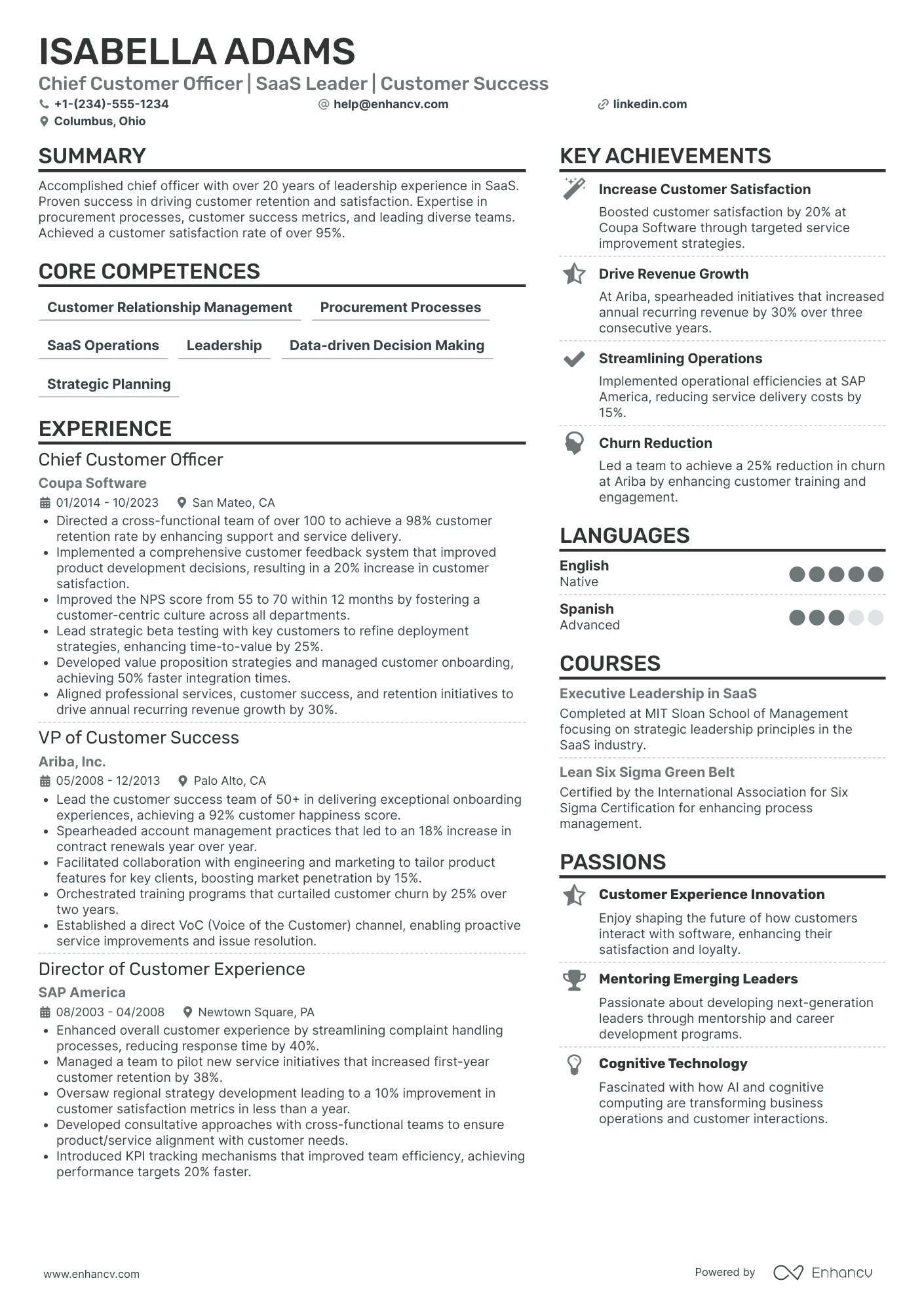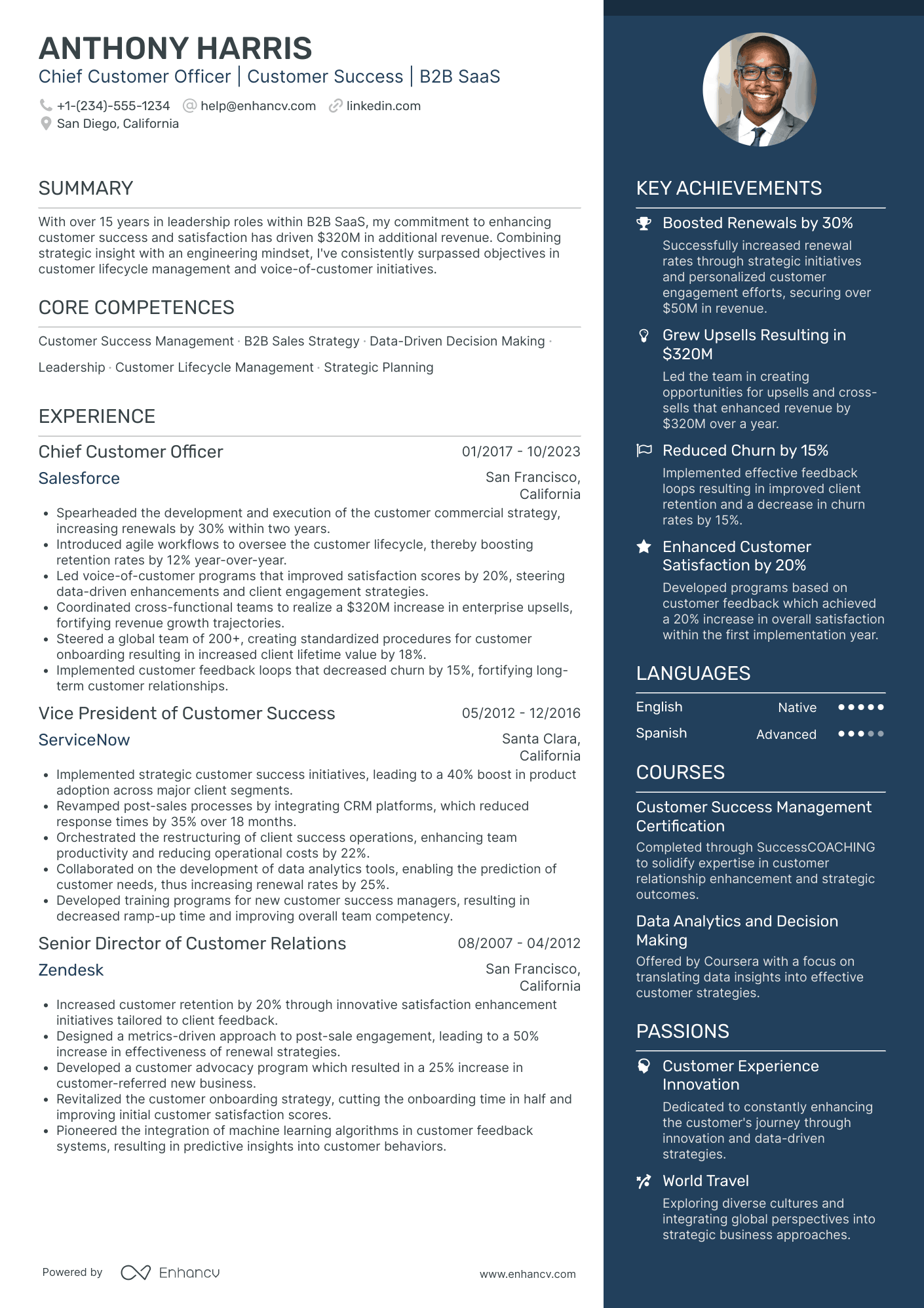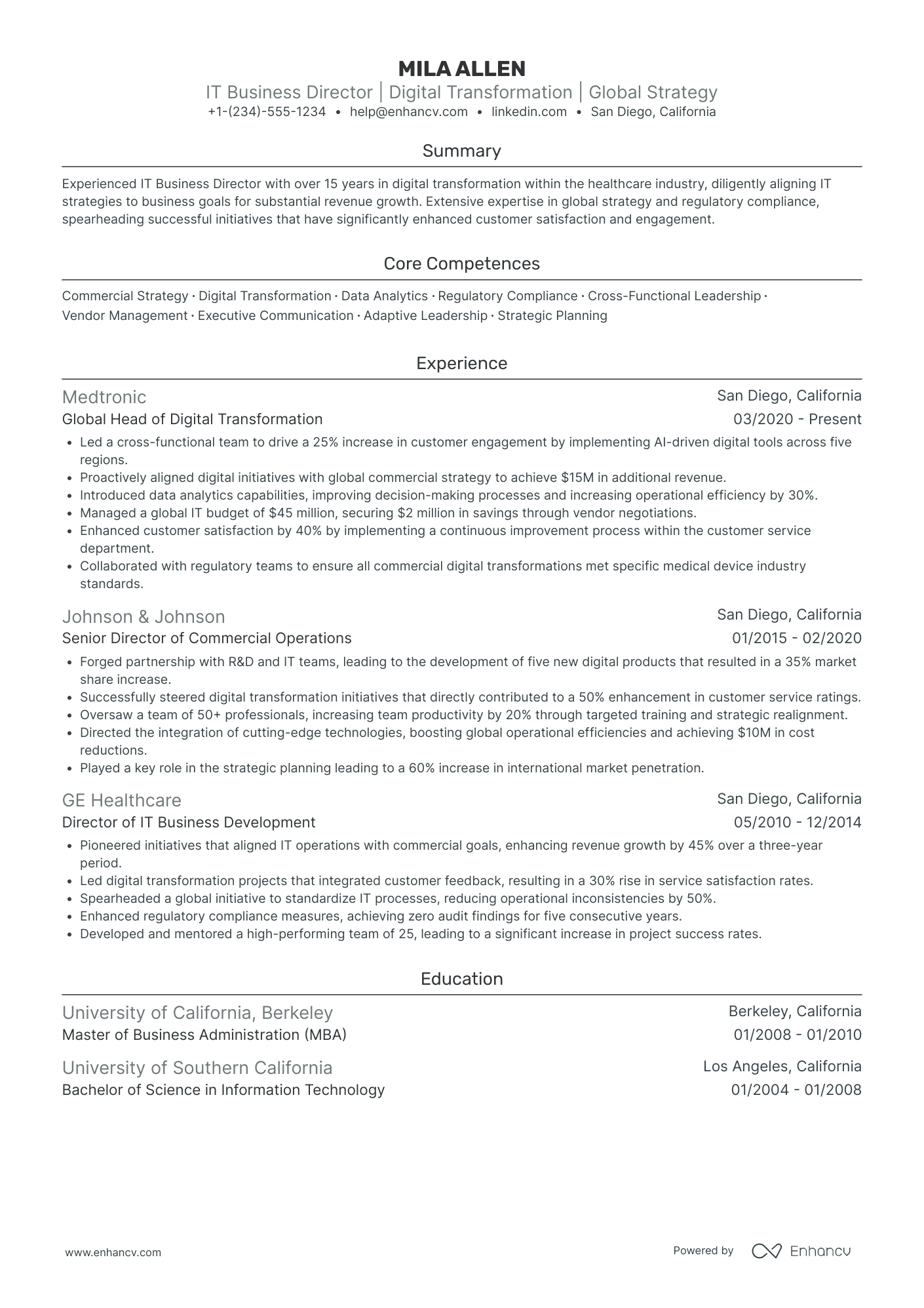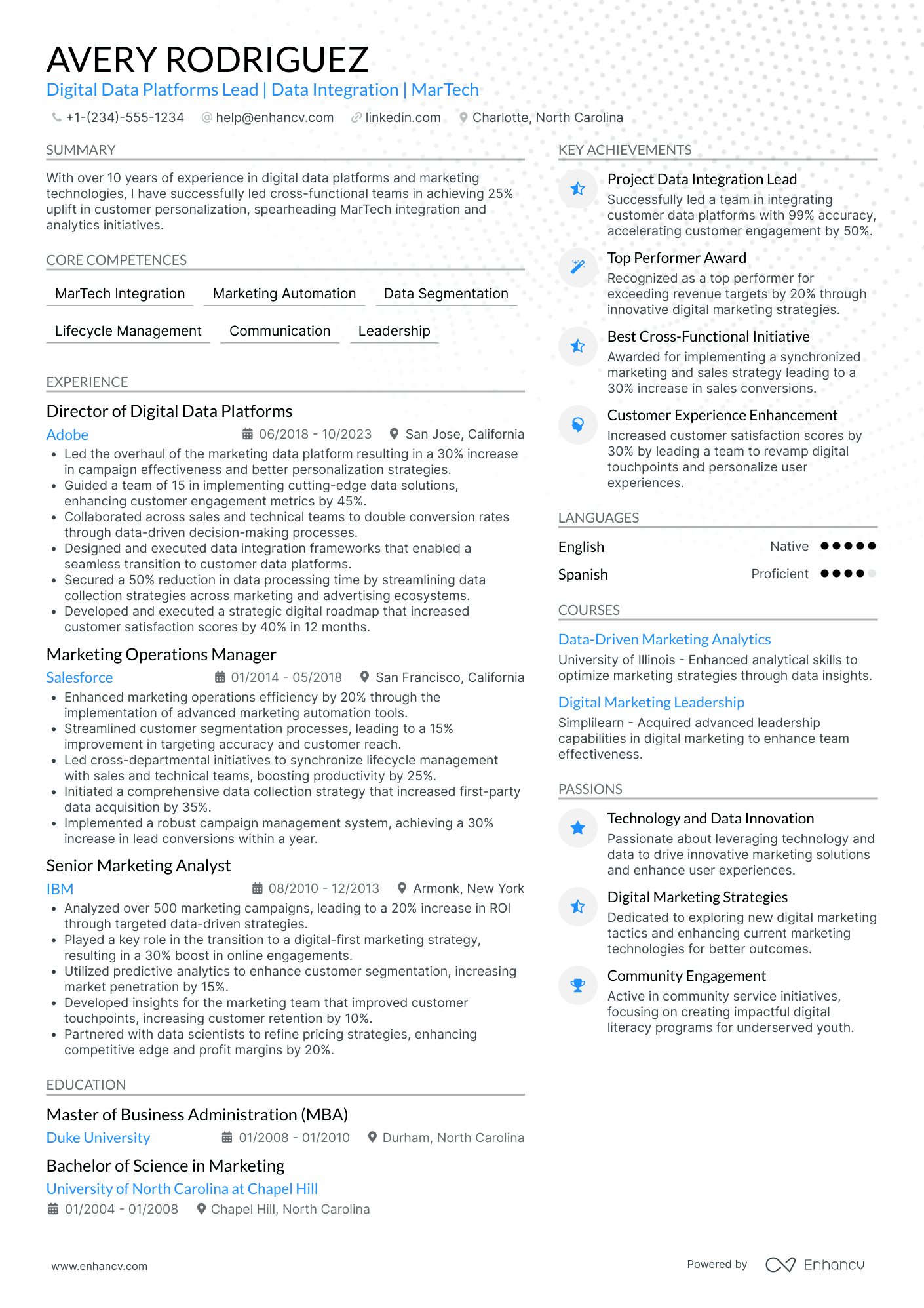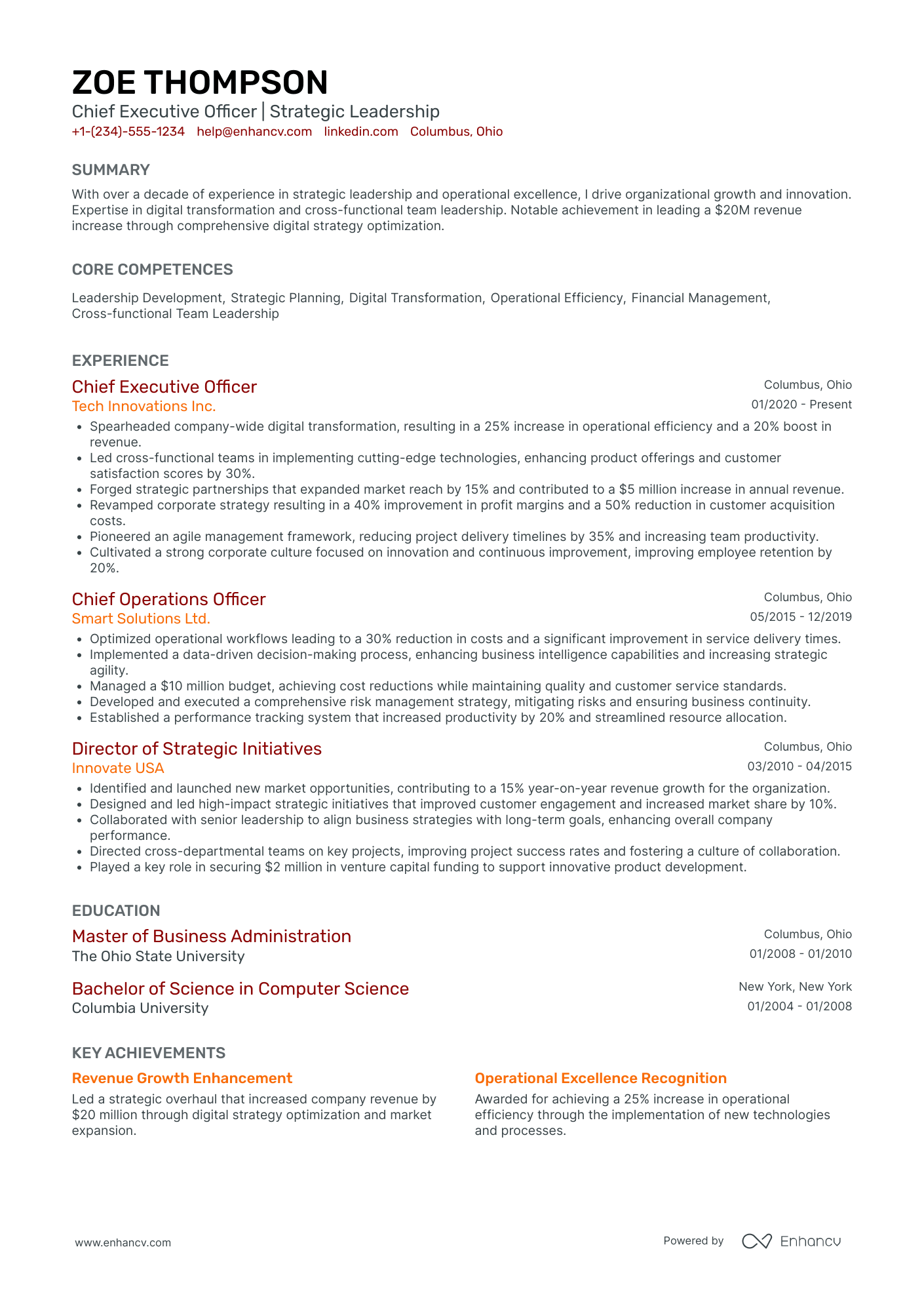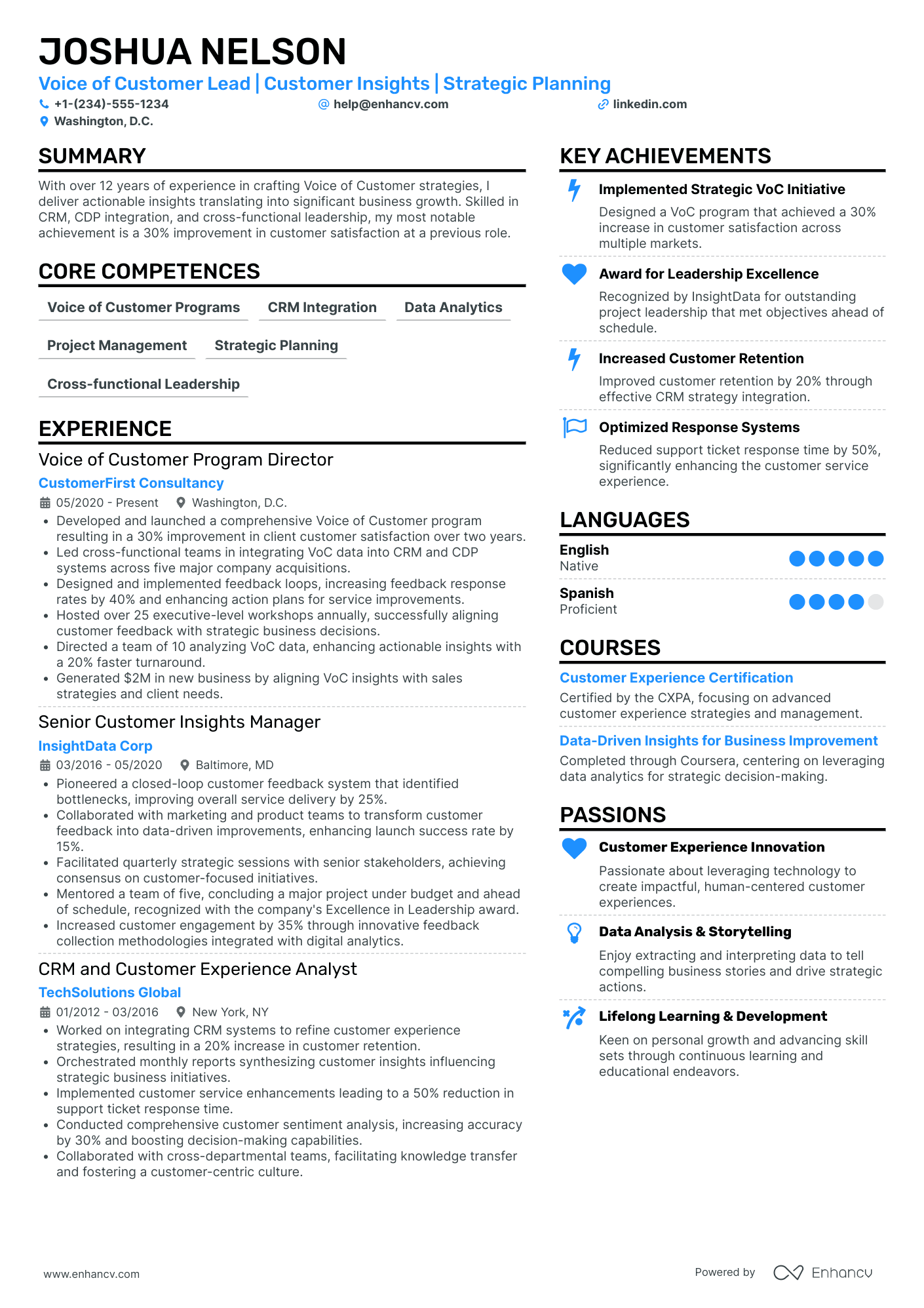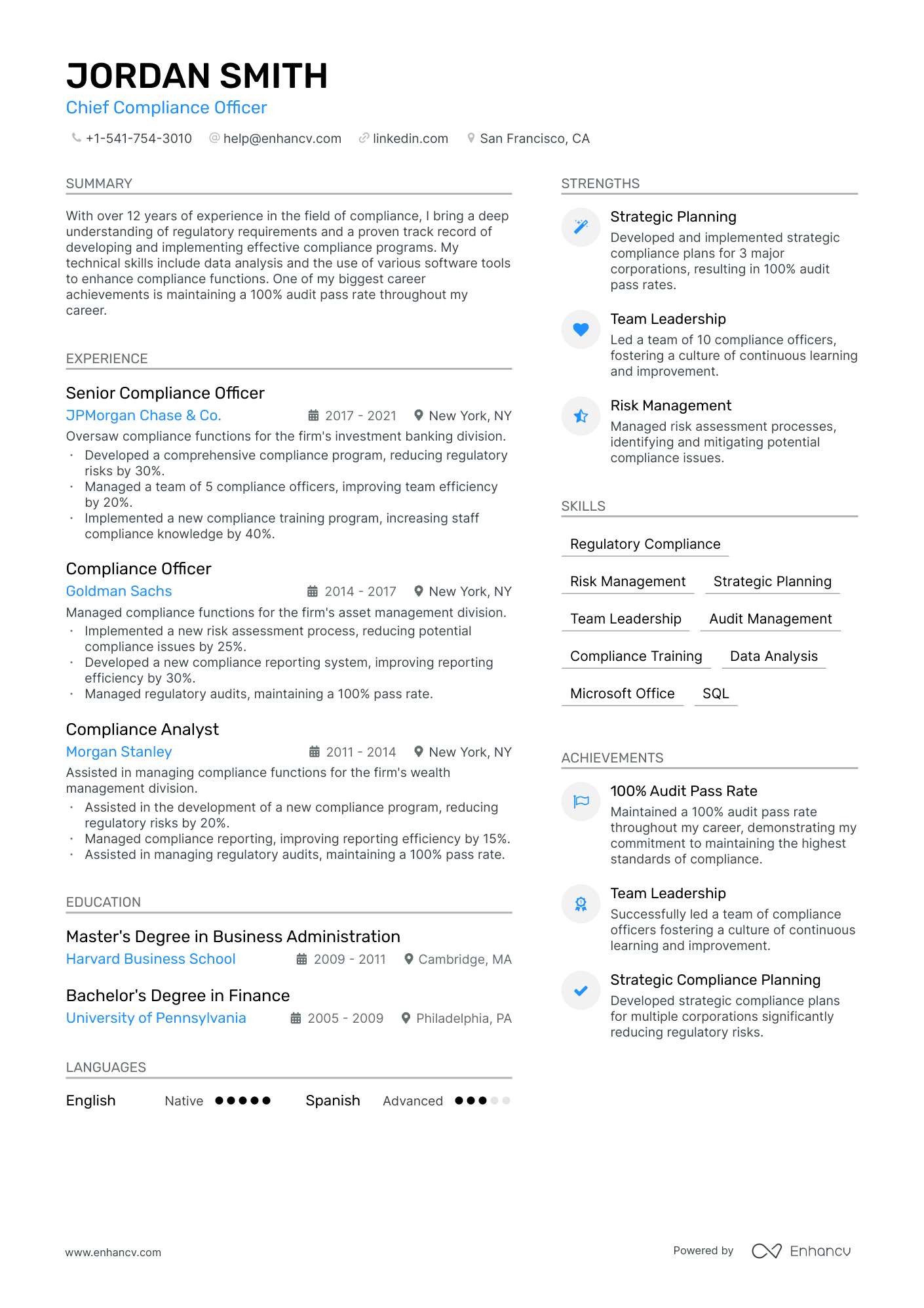The race for compliance leadership roles is intense. Even if you have top skills in communication, leadership, decision-making, and a strong grasp of regulations, it's tough to put all that knowledge into a short resume. But don't worry! In this guide, we'll tackle this problem and show you how to make a great Chief Compliance Officer (CCO) resume.
Here’s what you’ll learn:
- Read through a compelling Chief Compliance Officer resume example that demonstrates effective communication strategy implementation.
- Learn how to spotlight significant communication campaigns or crisis management successes.
- We’ll show you how to detail your proficiency in modern communication tools and platforms, highlighting adaptability.
- Emphasizing experiences in cross-functional collaboration, illustrating the ability to unify a company's messaging across departments.
Before diving deeper into the guide, here are some related guides to bookmark for later reference:
Chief compliance officer resume example and what does it do well
- This resume highlights achievements with quantifiable metrics, such as reduced risks, and maintaining 100% audit compliance. This offers concrete evidence of the candidate's proficiency and impact.
- Listing specialized skills such as "Regulatory Compliance," "Risk Management," "Audit Management," and familiarity with "SQL" and "Data Analysis" showcases the candidate's technical proficiency and ability to navigate the complexities of compliance.
- Phrases such as "Managed a team of 5 compliance officers" and "Led a team of 10 compliance officers" highlight the candidate's leadership capabilities, which are crucial for a Chief Compliance Officer role.
- Mentioning degrees from notable institutions like "Harvard Business School" and "University of Pennsylvania" can stand out to employers as these schools have a reputation for rigorous academic and professional preparation, as well as powerful networking opportunities and lifelong learning.
How to format a chief compliance officer’s resume
Headhunters are often quite picky when hiring a new Chief Compliance Officer due to the importance of the role.
Therefore, landing a job as a Chief Compliance Officer (CCO) is going to take a lot of focus when it comes to building your resume. You must take all the right steps to capture the recruiter’s interest and shed a positive light on your expertise and talents.
To do that, there are a few resume writing guidelines to stick to and a lot of mistakes to avoid.
The most important thing is this:
Always tailor your resume to the specific job you’re applying for to meet the hiring company’s needs and expectations. Go through the job description to identify duties, top requirements, and keywords.
Once you know what you’re aiming for, you’ll start building your resume.
What are the best practices for writing a job-winning Chief Compliance Officer resume?
- Keep your resume to two pages by prioritizing tailored skills and experience.
- Use a reverse-chronological resume format to showcase your work history and achievements.
- Choose one or two resume fonts consistently to maintain a clear hierarchy, ideally Lato, Rubik, or another readible sans-serif font.
- Use a modern color combination to make your resume more attractive.
- Include contact information data in the header of your resume, such as a personal but professional email address, a phone number, a link to your LinkedIn profile, and a short address (City and State).
- Save your file in PDF format to maintain your format and design.
Keep in mind market-specific formats – for example, a Canadian resume might follow a different structure.
Ensure your resume looks professional and ATS-friendly by running it through our resume checker software:
Is your resume good enough?
Drop your resume here or choose a file. PDF & DOCX only. Max 2MB file size.
The top sections on a Chief Compliance Officer (CCO) resume:
- Summary of Compliance Expertise: Offers a concise snapshot of the candidate's overarching experience, achievements, and value proposition in the compliance field.
- Compliance Career Experience: Chronicles the candidate's professional journey, detailing roles, responsibilities, and specific accomplishments in each compliance position.
- Educational Qualifications: Highlights relevant academic achievements, especially those that contribute directly to the candidate's competence in compliance.
- Skills & Competencies in Compliance: Enumerates technical, soft, and hard skills essential for effective risk management, regulatory adherence, and team leadership.
- Certifications & Training in Compliance: Lists specialized credentials and courses that emphasize the candidate's commitment to staying updated in the constantly evolving regulatory landscape.
What recruiters want to see on your resume:
- Proven track record of implementing and overseeing successful compliance programs.
- Demonstrated leadership skills, especially in guiding and mentoring compliance teams.
- Certifications or advanced degrees in regulatory compliance or related fields.
- Experience with specific compliance software, tools, or platforms utilized in risk management and auditing.
- Tangible achievements such as positive audit results, risk reductions, or influential compliance policy development.
How to unpack your chief compliance officer resume experience
The experience section is where you go back through your work history and tell recruiters the things they want to know. This is exactly what will make your resume captivating in a pile of highly-competitive job seekers.
A quick reminder:
If you haven’t done it yet, this is the time to go through the job ad and identify the hiring company’s challenges.
For each relevant job you include, add the following details:
- Job title
- Company name
- Employment years
- Description (optional)
- 3-5 bullet points featuring your achievements in the job
We’ll get in a moment to the dos and don’ts of writing an experience section for Chief Compliance Officers. But before we do that, let’s see some examples.
- •Helped with developing an annual compliance work plan
- •Trained and supervised a high performing team of compliance professionals
- •Responsible for identifying potential areas of compliance risk
An experience section such as this one can barely get headhunters excited to read more about you — let alone hire you!
Here’s how to make your Chief Compliance Officer (CCO) work experience interesting:
- An impactful experience section must be personalized using job-specific career wins, skills, and results.
- Accomplishments can only leave an impression and be impactful if they’re quantifiable through metrics and data.
- Optimizing the experience section with relevant keywords and phrases is the secret to beating applicant tracking systems (ATSs).
- Strong language using active verbs does a better job of highlighting your contribution to the workplace.
Here’s how the experience section should look like with the proposed changes above:
- •Implemented appropriate controls for Vendor Management, FDCPA, UDAAP, as well as other bank regulatory requirements
- •Monitored and revised the organization's compliance initiatives in response to changes in regulation laws
- •Trained and supervised a team of 16 compliance professionals to maintain the highest professional ethical standards
How to quantify impact on your resume
Here are some examples of work situations you can quantify and put into measurable achievements:
- Include the number of years spent in compliance roles to showcase the depth of industry experience.
- Highlight the percentage reduction in compliance violations or risks achieved under your leadership to demonstrate effectiveness.
- Detail the number of team members managed, reflecting your capacity to lead and mentor.
- Specify the total budget overseen for compliance activities, indicating fiscal responsibility.
- Mention the number of successful audits completed, showcasing a history of thoroughness and regulatory adherence.
- List the number of training sessions conducted or coordinated, showing commitment to continuous learning and team development.
- Indicate the percentage increase in team efficiency or reporting accuracy due to your initiatives.
- Note the number of compliance projects or programs initiated and successfully completed, reflecting proactive strategy implementation.
What are the best hard skills and soft skills for your chief compliance officer’s resume?
It's always crucial to have a separate "Skills" section that further highlights your skillset and proves your competence. You'll use it to include skills in an easy-to-read format that attracts recruiters.
The three golden rules for creating a perfect Chief Compliance Officer skills section are:
- Match your talents to the job description to stand out
- Avoid basic and outdated skills, such as "Focus skills" or "Web search"
- List a combination of soft and hard skills to show that you're a polymath
How do soft and hard skills differ?
Soft skills are any transferable character traits that can help you be productive and better interact with your work environment. That includes interpersonal skills — such as leadership, teamwork, and communication.
Hard skills are talents that you acquire through practice and experience. They're vital for your success as a chief compliance officer, which makes them highly sought-after by headhunters.
Here's our list of the best Chief Compliance Officer (CCO) soft and hard skills to include in your resume - select a handful of them for this section.
Best hard skills for your Chief Compliance Officer resume
- Regulatory Compliance
- Risk Management
- Compliance Software Proficiency
- Audit Management
- GRC (Governance, Risk, and Compliance) Tools
- Data Analysis
- Financial Reporting
- Anti-Money Laundering (AML) Systems
- Know Your Customer (KYC) Processes
- Ethics Management
- Policy Development
- Fraud Detection
- Cybersecurity Protocols
- Enterprise Risk Management Software
- Contract Management
- Legal Research
- Global Regulatory Frameworks
- SQL for Compliance Querying
- Compliance Training Development
- Incident Response Management
Best soft skills for your Chief Compliance Officer (CCO) resume
- Leadership
- Communication
- Decision-making
- Problem-solving
- Ethical Judgment
- Strategic Thinking
- Negotiation
- Time Management
- Attention to Detail
- Empathy
- Adaptability
- Teamwork
- Conflict Resolution
- Influencing Skills
- Critical Thinking
- Resilience
- Listening Skills
- Diplomacy
- Assertiveness
- Integrity
Do you need education and certification sections on your resume to increase your chances of getting an callback?
Most companies require a college degree before hiring a chief compliance officer. That's because having a relevant educational background shows that you have theoretical knowledge on top of your expertise.
To add education to your Chief Compliance Officer resume:
Create a separate education section on your resume. Then, add to it a bachelor's degree in any relevant field — such as business administration, health care, or law.
Sometimes, the job application will specify which study fields are required.
The education section must include the following details:
- Degree title (.i.e Bachelor of Science)
- University name
- Graduation year (or years attended)
- University location (optional)
- GPA (optional)
Here's what that should look like on a Chief Compliance Officer resume:
On the other hand, certificates on your resume show that you have the necessary skills and knowledge to thrive in the job role. But on top of that, they also serve as solid proof of your interest in your career and willingness to invest more in yourself.
Both qualities are highly sought after by recruiters and can get you noticed among dozens of other applicants.
In many occasions, the hiring company will specify which certificates it’s looking for in the job offer under requirements. Unfortunately, not having a required certificate will often minimize your chances of getting shortlisted.
But even when not asked for, you can list any Chief Compliance Officer certificates to edge out the competition.
Best certifications for your Chief Compliance Officer resume
- Certified Compliance & Ethics Professional (CCEP)
- Certified Regulatory Compliance Manager (CRCM)
- Certified Anti-Money Laundering Specialist (CAMS)
- Certified Information Systems Auditor (CISA)
- Certified Information Security Manager (CISM)
- Certified Risk and Compliance Management Professional (CRCMP)
- Certified Information Privacy Professional (CIPP)
- Certified Fraud Examiner (CFE)
- Certified Internal Auditor (CIA)
- Certified Risk Professional (CRP)
How to write an impressive chief compliance officer (cco) resume summary
The summary is a 4-7 sentences paragraph that highlights your achievements, skills, educational background, and your certificates. It's a short section that provides an overview of your career so far.
Of course:
"Short" doesn't mean basic, generic, or ambiguous. You want every word in the summary to encourage recruiters to read the next sections and discover more about you.
A few tips for writing a job-winning resume summary:
- Only include relevant talents and accomplishments
- Leave out any personal pronouns to maintain a good sentence structure
- Use job-relevant keywords to increase beat applicant tracking systems
- Write it last - you’ll be able to overview your whole experience this way
Let's take a look at a couple of summary examples:
This summary misses the mark on several occasions:
- The summary is too generic. It doesn't provide any specific details about the candidate's achievements, the size or type of companies they have worked for, or any particular industries they specialize in.
- The title "Chief compliance officer" and the responsibility of "identifying potential areas of compliance risk" are somewhat redundant. Most people familiar with the role would assume that a Chief Compliance Officer is responsible for this.
- The summary mentions "extensive experience in risk management" and "communication and leadership skills" but doesn't provide any metrics, examples, or achievements to back up these claims.
- The text reads more like a list of job duties rather than a cohesive summary. Ideally, a resume summary should flow smoothly and be engaging to the reader.
- There's no mention of any key accomplishments, the impact the candidate has made in previous roles, or any specialized knowledge or certifications they might possess.
This revised version provides specific details, highlights achievements, and mentions a relevant certification, making it more compelling to potential employers.
Optimize your resume summary and objective for ATS
Drop your resume here or choose a file.
PDF & DOCX only. Max 2MB file size.
Additional sections for a chief compliance officer resume
Aside from expertise in the workplace, a new Chief Compliance Officer is going to spend a lot of time interacting and collaborating with others. Thus, it's crucial for a hiring manager to pick an applicant who's delightful to be around.
You show that by adding resume sections that reflect your fun character and agreeable personality, such as:
- Proprietary Enhancv sections such as “A Day of My Life” and “Life Philosophy”;
- Passions, interests and activities;
These sections can help you share your complete story with confidence — especially when relevant.
Moreover, the following sections can back your resume experience up, but only add them if you have space on your second resume page. They are not essential, but make up for an interesting and engaging resume. These include:
- Professional Affiliations & Memberships: Displays alignment with reputable compliance organizations or associations, indicating ongoing engagement with the industry.
- Awards in Compliance: Celebrates notable achievements, honors, or awards received in the compliance realm, showcasing distinction in the field.
- Languages Proficiency: Highlights the ability to operate in multiple languages, potentially essential for global firms or those with diverse clientele.
- References: Provides contacts of industry peers or supervisors who can vouch for the candidate's skills, character, and aCCOmplishments in compliance.
Key takeaways
- Start by reading the job offer to identify the hiring company’s needs, then create a targeted resume just for that;
- Break down your resume into separate sections to feature your expertise, different skills, and multiple competencies;
- Stick to HR-approved formats and resume layouts to make it through applicant tracking systems and attract recruiters;
- Concentrate on relevant, measurable aCCOmplishments to highlight your impressive work performance;
- Enhance your Chief Compliance Officer resume by including additional sections that show your impact and personality — such as “Projects” “Awards” or “Passions”.
